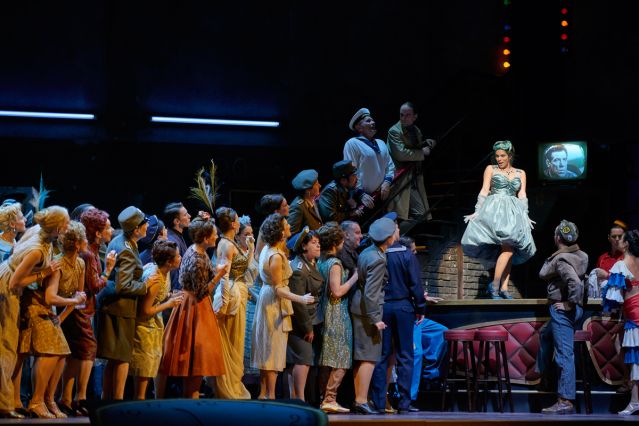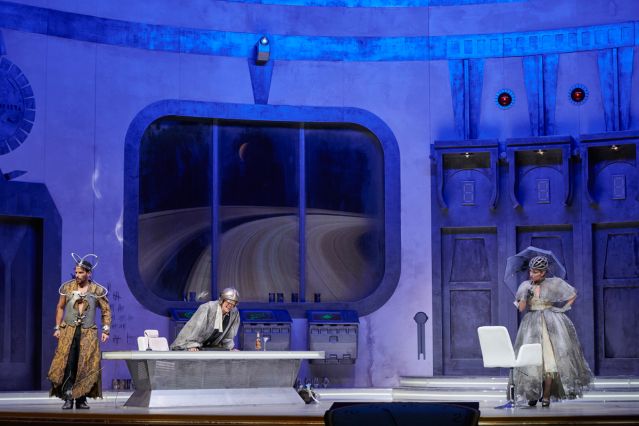„Fledermaus“ forever - Deutsche Oper Berlin
„Fledermaus“ forever
Director Rolando Villazón in conversation with dramaturg Lars Gebhardt
For all their comedic and entertaining aspects, the operettas of Jacques Offenbach – which served as the model for Viennese operetta – always incorporated a healthy dollop of social criticism. The gods asleep in Olympus in Act 2 of ORPHEUS IN THE UNDERWORLD, for instance, reflect the political reality of Paris in the 1850s. In THE BAT Strauß and his librettist and colleague Richard Genée hold a mirror up to their upper-class audience, in whose image the characters onstage were made. How does a director approach all that? Do we still have Adeles, Rosalindes and Eisensteins in today’s society?
Of course we do. All those archetypes are part and parcel of modern society: the unhappy bourgeois spouses, whose lives have become routine; the notorious two-timing man; the wife desperate to leave her daily drudgery behind her and managing to get her own back on her husband; the maid or female employee, who wonders why these people presume she’s a second-class citizen, where in fact she’s fully able to grow and make good.
That’s why it’s important for me to use modern people and modern language in my production of THE BAT. Even back when it was written THE BAT had a sizeable chunk of escapism built into it. They’d just had a major financial crisis, the middle classes were shaken, and we’re presented with partying, intoxication, double standards, with the characters onstage basically telling the audience, ironically: “Happy is he who can forget things that can’t be changed.” These voices can be heard today, too, and we also have a huge entertainment machine helping us to forget all the sad, bad, evil stuff in the world around us – just as we did back then.
The operetta was based on a French vaudeville text and has all the ingredients which go to make up a well-crafted comedy and are familiar from commedia dell’arte, Viennese popular theatre and farces: the smart maid, the jealous husband, the woman on the verge of a nervous breakdown, the lover hiding in the cupboard, the oafish servant. What is it about adultery, disguise and jail that we find so funny?
If you ask me, comedy is essentially about exaggerating real life. In the course of a rather whacky night the characters in THE BAT experience a string of absurd situations – and suddenly we, the audience, start recognising ourselves at various junctures in the story. We see ourselves reflected, as in a mirror: “Uh-oh, déjà vü.” Or: “I’ve been there!” Or we glimpse characters onstage that we know in real life – enlarged, exaggerated, caricatured, but still accurately captured in the operetta. That’s where the comedy lies, for me: at the point where reality comes crashing in.
Doesn’t the character of Eisenstein have a vein of comedy all his own? The well-off, insouciant patrician who’s shown up? The degradation of his status from rapscallion to a husband made to look stupid?
I don’t thing Eisenstein and the way he acts is particularly funny. In theory you can take the storyline and make a tragedy out of it: rich man suddenly has to struggle for something. He turns up at Orlofsky’s party and is out of his comfort zone, has to apologise to Adele, his employee, has to drink when he’s told to, gets his tool of seduction pinched… and over all the goings-on hangs the cloud of the jail term he’s about to start. The ground seems to have shifted beneath Eisenstein’s feet. Comedy is very much a factor of those aspects that are presented as funny: the nervous despair conveyed by Eisenstein, the knowledge advantage that the audience and the other characters have, the interaction of disguised wife and disguised husband… It’s a little unsettling to witness someone having to accept a whole new reality and a new set of structures. We can acknowledge the gravity and truths underlying all the comedy if we want to, but we don’t have to. To one observer it’s just a funny sketch, like: “It made me laugh. Next!” Another observer may reflect on some of the issues on the way home. That’s what’s so fantastic and difficult about comic material: getting the balance right between slapstick, humour and that little kernel of truth at the heart of everything.
THE BAT doesn’t really have a main character. Or the stories of a number of characters are being told in parallel. Within a brief period of time, stretching from afternoon through the night to the early morning of the next day, the characters find that their lives have been changed in some way or another. Whose life has changed most? Whom do you see as the central character?
In my mind it was always Adele. Adele’s the one who’s most changed at the end. She takes the chance when it comes and won’t be returning to her old existence. She rejects the condition that society has allotted her: “You’re a maid and always will be!” she has always been told, but she bucks that dictum: “That’s why I advise you to take more care when sizing people up!” she snaps at her boss. She shows Eisenstein that his idea of the bourgeoisie and class differences is outdated or is at least beginning to crumble. I see a link to Orlofsky in Adele’s fire, in her strength. Something about Adele draws him out of his nihilistic attitude to life. “I’ve seen it all. Everything bores me stiff…” And suddenly the penny drops and Adele wakes him – or wakes his attitude – with a kiss. In our production it was important for me to go on the offensive with Orlofsky’s trouser-wearing role: a man as a woman, a woman as a man, and shades of grey in between. I love the shimmering androgynous quality of it all.

And Eisenstein’s attitude?
I’m not so sure if Eisenstein has gone through a process of change. I think it’s important to him that Rosalinde doesn’t dump him. And he’ll probably pull himself together for a few months and then grab the first opportunity to get his end away. There’s something naïve and charming about him. He lives for the moment – and that’s not going to change.
The question facing Rosalinde at the end of the operetta is: do I stay with someone like this or not? The way the thing is written and composed suggests that she’s decided to go back to the status quo ante. In my eyes that speaks not so much of resignation as of a shrugging of the shoulders, like “Okay, whatever. That’s how it is. Life goes on.” It’s quite similar to the end of COSI FAN TUTTE: what are the pair of them going to do now? In the course of the night each has seen the other in a different light – and just maybe their marriage will survive because of it.
And Falke: for him it’s first and foremost an issue of vengeance. In Act 2 he says: “He who laughs last, laughs longest.” And what happens? At the end he’s the one laughing the longest! He’s got what he wanted. And maybe there’s another parallel there with COSI FAN TUTTE, this time with regard to the Don Alfonso character, who steers and manipulates. At the end, when they all sing in unison “And we were all in on it”, it’s only an excuse – no one was aware of the extent to which Falke was pulling the strings.
Time and forgetting are an important part of THE BAT. Falke persuades Eisenstein to delay starting his jail term by going to the ball. Eisenstein uses a lady’s watch to seduce women. The chimes of the clock mark the end of the party and call Frank and Eisenstein, who by now are the best of pals, away to jail – for quite different reasons. In your production time is “a strange little thing”…
I and the team asked ourselves what it was about THE BAT that still gave it impact today. What is it about the farce that interests us? Obviously the marvellous music, the tunes, the rhythm and what have you. But it’s also down to the story, which – if we’re honest – could just as well happen in the present day. It was important to us that we stress the timelessness of the theme. It’s a comedy about the bourgeoisie – and regardless of all the obituaries written to it, we still live in a bourgeois age.
Our production sets each act in a different age. The audience is eased into THE BAT in the traditional period setting, in a predictable middle-class drawing room of the 1870s, as is to be expected, yet even there the action onstage is ruffled by the occasional disturbance from the present day. Act 2 is set in the 1950s in a divided Berlin – which in my mind is the perfect framework for the subversive, clandestine, even anarchistic quality of the festivities at Orlofsky’s villa. And Act 3 plants us in the future – but it’s a future that’s already crumbling.
The inspiration for this rather dystopic future comes from any number of pop-culture influences, the great sagas about space travel and the like. Is that how you see the future: broken space stations and dysfunctional androids?
No, I just think the future won’t be that different from the present. For a long time, the word was that the future would be all hunky dory. We now know it won’t be like that. Technology is getting more and more important, but it’s still dreamt up and manufactured by human beings – and hence imperfect. And also not completely predictable. And robots and androids are already beginning to supplant us humans. In Paris they’ve got driverless tube trains. Shops soon won’t need to employ any staff. The artificial person is getting closer and closer to reality. It was a nice challenge taking the doltish public servant, Frosch, – a role that’s always been a vehicle for topical references, improvisation and jokes – and portraying him in a different light, without impairing in any way the fundamental structure of Act 3.

The influence of films like “2001: A Space Odyssey” are obvious in Act 3, but we’re reminded of Hollywood in Act 2, too. Billy Wilder’s “One, two, three” bigs up the Communists in occupied East Berlin and gives us the iconic image of Lieselotte Pulver dancing on the table. Why does Act 2 toy with these images? What led you to opt for the GDR of the 1950s?
Firstly, we’re in Berlin. I love the city with its history. The postwar years are fascinating. The GDR was an experiment in the 1950s; no one knew which way it would tip. Prior to the building of the Wall there was more communication, more interaction with the West. I find this brief moment of neither-in-nor-out, when rules and morals and laws were still being formulated, quite interesting. And in that context Adele’s aria is riveting: in this environment there are no princes, no marchionesses, no maids. Everyone’s equal – aren’t they? Everyone’s caught up in the disguises, masks and intoxication. Act 2 is all about liberty and overstepped boundaries.
We also have to bear in mind that the familiar “Du” form of address that Falke offers to everyone at the ball was a nigh on revolutionary gesture in the 1870s. Even spouses used the formal “Sie” with each other and as late as the 1920s children would start off with “Sie, mum and dad” when addressing their parents. The waltz, too, was new and not yet considered a respectable dance. It can’t be stressed enough that THE BAT was subversive, revolutionary and cutting-edge.
Exactly! Which is why all acts feature thoroughly modern people but in different settings. It’s one big pantomime, a parable, a game.





